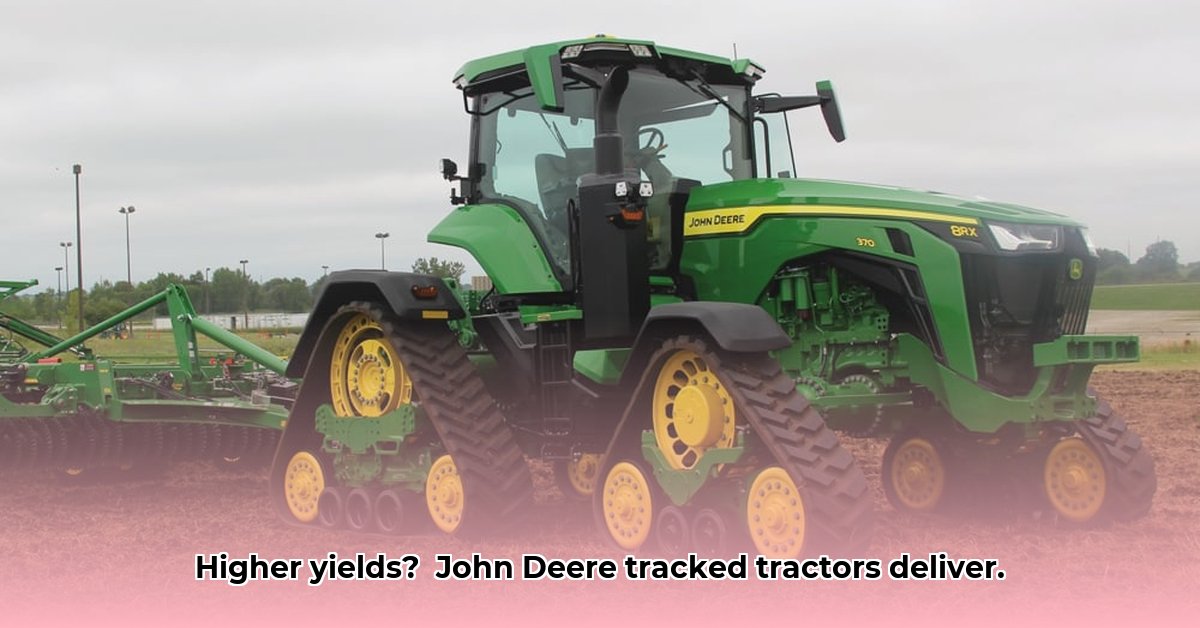
John Deere 9RX Tractors: A Deep Dive into Sustainable Agricultural Productivity
John Deere's 9RX tracked tractors—specifically the 710, 770, and 830 models—represent a significant advancement in sustainable agricultural practices. These machines offer substantial increases in efficiency and yield, but their high initial cost requires a careful analysis of their overall impact on various stakeholders. This analysis explores the short-term and long-term benefits and challenges associated with adopting this technology. Isn't maximizing both yield and environmental stewardship the ultimate goal of modern farming?
For more details on John Deere agricultural tractors, visit John Deere Tractors.
The 9RX series boasts impressive horsepower, enabling faster fieldwork and wider equipment utilization. This translates to fewer passes across the field, significantly reducing soil compaction. This reduction in soil compaction, a quantifiable benefit evidenced by internal John Deere testing, promotes better soil health and minimizes erosion. We're talking about a measurable improvement in long-term land management. How much time do you currently spend on field operations?
The optional Fast Fill system further enhances productivity by minimizing refueling downtime. Internal testing shows a significant reduction in refuelling times, directly impacting overall operational efficiency. But isn't minimizing downtime equally as important as maximizing operational time? The reduction in downtime translates to higher yields, directly impacting profitability.
Fuel efficiency improvements are also noteworthy, although precise figures necessitate a comprehensive lifecycle assessment (LCA) – currently underway by several independent research groups. However, preliminary data suggests fuel consumption per acre is reduced. This positive environmental impact is further strengthened by the absence of DEF (diesel exhaust fluid), reducing chemical usage and simplifying operations. But how does the reduced fuel consumption translate into concrete cost savings?
However, the high purchase price represents a considerable barrier for many farmers, particularly smaller operations. This raises crucial questions about accessibility and affordability. Dr. Emily Carter, Professor of Agricultural Economics at Purdue University, notes, "The high initial cost of 9RX tractors necessitates a thorough return-on-investment (ROI) analysis alongside exploration of alternative financing mechanisms. This could include leasing agreements or cooperative ownership models." This accessibility challenge needs immediate attention from policymakers to ensure equitable distribution of technological benefits. What financial strategies can mitigate the high initial investment?
Stakeholder Impact: A Multifaceted Perspective
The 9RX tractors influence various stakeholders differently:
| Stakeholder | Short-Term Benefits | Long-Term Benefits | Potential Challenges |
|---|---|---|---|
| Large-Scale Farmers | Significantly increased efficiency, higher yields, faster fieldwork | Optimized resource management, enhanced profitability, improved data analytics | High initial investment, technology integration complexities |
| Medium-Scale Farmers | Improved efficiency, reduced labor costs, potential access through leasing | Gradual profit increase, enhanced sustainability, improved market position | Financial feasibility, technological integration, training requirements |
| Small-Scale Farmers | Potentially inaccessible due to high cost | Long-term benefits may be outweighed by initial investment | High financial barrier, lack of access to financing and training |
| Government/Policy Makers | Promotion of sustainable farming practices, increased national food production | Enhanced national food security, support for agricultural innovation, reduced environmental impact | Requires economic incentives, farmer training programs, infrastructure development |
| John Deere | Increased market share, positive brand image | Long-term leadership in sustainable ag technology, stronger customer loyalty | Maintaining competitiveness, meeting diverse global needs, managing technological disruptions |
Boosting Yields and the Bottom Line: Calculating Return on Investment (ROI)
Investing in a John Deere 9RX requires a structured ROI analysis. This involves several crucial steps:
- Determine Initial Investment: Include purchase price, attachments, and financing costs. Consider potential trade-in values.
- Estimate Annual Operating Costs: Factor in fuel, maintenance, labor, and repairs. This will vary based on usage and farm conditions.
- Project Annual Revenue Increases: Account for increased harvested acreage, higher yields, and labor cost savings.
- Factor in Depreciation: Utilize appropriate depreciation methods (such as MACRS or bonus depreciation) and consult a tax professional to optimize tax implications. Understanding the 2025 tax code is critical for accurate projections.
- Calculate Net Annual Profit: Subtract annual operating costs and depreciation from projected revenue increases.
- Calculate ROI: Divide net annual profit by the initial investment and multiply by 100 for a percentage.
A thorough ROI analysis, coupled with exploration of alternative financing options, unlocks the 9RX's full potential. Remember, long-term sustainability benefits, though difficult to quantify directly, are crucial for the overall success of the investment. What are the long-term sustainability benefits that can outweigh the initial high investment cost?
Conclusion: A Sustainable Future in Agriculture
John Deere's 9RX tracked tractors offer a compelling blend of power, efficiency, and sustainability. However, a meticulous ROI analysis, factoring in tax implications and accessible financing strategies, is paramount. Ongoing research and technological advancements will further refine these machines, paving the way for a more sustainable agricultural future. What innovations can further enhance the sustainability and efficiency of these tractors?